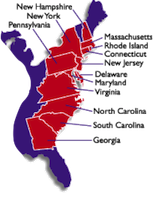We Don’t Need Learning Styles
 AMiddleWebBlog
AMiddleWebBlog
So where were you when you first heard the news that the theory of student learning styles doesn’t hold up under scientific scrutiny?
Headlines such as Learning Styles Debunked and Learning Styles Re-evaluated hit the educational scene back in 2009. I remember going from link to link while my thoughts ranged from intrigue to skepticism. I just couldn’t wrap my mind around the attack on the learning style theory that I was trained to believe. Could it really be true that the theory I thought about every day as I considered the needs of my students was a fallacy?
For quite awhile I just couldn’t buy into it. It wasn’t until I began to read the work of cognitive psychologist Daniel Willingham that I started to make friends with the idea. And now, nearly five years later, after further study, research and new knowledge gained through my investigation of the Universal Design for Learning, I have put the pieces together.
With all due respect to the skeptics out there (I understand that many educators really “own” this idea), the learning style theory just doesn’t play a major role in my thinking as a teacher anymore. Have I shocked anyone? Allow me to connect all the dots…
Perspectiveshift
As far back as 2005, cognitive psychologist Dr. Daniel Willingham starting shaking the education tree with articlessuch as this one making the outrageous claim that learning styles simply do not exist. It caused some stir, but I remember most teachers I knew just blew it off as crazy. It wasn’t until I watched this video clip in 2008 that I began to think, Hey, I should really keep an open mind about this. It seemed to connect with some of my own experiences in the classroom. But as I say, until I really started digging into what Willingham was saying, the puzzle pieces didn’t all start clicking together.
The short version: All people learn differently—no one is arguing that. As Willingham explains, some learners are strong visual thinkers and some are better at remembering auditory stimuli. But it’s what happens in schools when these differences are “recognized” that’s all wrong.
Those students who are pegged by teachers as visual or auditory learners have the potential to become limited in their views of themselves as learners. Let me explain. For the learning style theory to be true, an auditory learner would always learn best through hearing the sounds of words, for example. The truth is that sometimes all of us need visual, auditory, or kinesthetic cues.
 For example, one of my students was identified as an auditory learner — it said so on his IEP. To stay consistent with the learning style theory this would mean that when we were learning about the 13 colonies, he would need to hear the sounds of the colonies to guide him to remember the information. But the truth is: for this history lesson it was a visual map that clinched his learning. He was not an auditory learner in this situation.
For example, one of my students was identified as an auditory learner — it said so on his IEP. To stay consistent with the learning style theory this would mean that when we were learning about the 13 colonies, he would need to hear the sounds of the colonies to guide him to remember the information. But the truth is: for this history lesson it was a visual map that clinched his learning. He was not an auditory learner in this situation.
The dangers that come from believing in the learning style theory can occur when teachers hear, for example, that a student is a kinesthetic learner, so they make sure to include manipulatives in a lesson. Yet sometimes the manipulatives can distract students from the focus of the lesson. This may result in the teacher saying, “I don’t know why he still doesn’t get it, I used manipulatives to meet his needs.”
In these examples, it was the context of the particular lesson and/or the particular environment — not learning styles — that needed to be in focus.
Rather than adhering to the learning style theory, I have come to see that learning is flexible and teachers can meet the variable needs of students through these principles of a universal design for learning. I mentioned in my last post that I believed that as teachers make the instructional shifts with the Common Core, they must also make what I call the perspective shifts. It doesn’t make sense to peg individuals as one type of learner or another. As Willingham states, “We’re really asking students to remember meaning. Most of what we want students to learn isn’t sound or visually based…it’s meaning based.”
Is anyone with me during this Aha moment? Do you see the potential for this perspective shift?
Thatelephantintheschool
 So, the lingering question: If learning styles do not exist then why do most people (including many educators) continue to go along their merry way as if they do?
So, the lingering question: If learning styles do not exist then why do most people (including many educators) continue to go along their merry way as if they do?
Willingham claims that the learning style theory seems so right because:
1. A large percentage of people have believed in it for so long.
2. Part of the theory is right — people do learn in different ways. But it’s the pegboard way these differences are addressed in the classroom that is wrong.
3. When the belief in the learning style theory is present, a person will continue to interpret future situations (especially ambiguous ones) as consistent with the theory. If you believe something to be true (and decline to consider contradictory evidence), you will have a strong tendency to interpret situations to be consistent with your belief.
I’ve asked a few learning-style diehards why they believe in the theory. Here’s the general response, I know my students, and no one can tell me that they do not have individual learning styles. Here’s the catch…they DO.
But the diehards aren’t paying close attention: Willingham and other thought leaders in this area are not denying that students learn differently. They are saying that we need to change our perspective about what “different” means for teaching and learning. One thing it doesn’t mean is pigeon-holing students into a single learning “box.”
 ThewayIseeit
ThewayIseeit
The learning style theory is not the glue that holds my lessons together. The way I meet the needs of diverse learners is by focusing on learner variability and providing access to the curriculum so that students may construct meaning in every way that works for them.
It’s not about creating lessons for specific learning styles. It’s about creating accessible learning environments by removing barriers, including those that cut students off from learning opportunities. Here’s a quote that sums it all up for me:
Good teaching is good teaching and teachers don’t need to adjust their teaching to individual learning styles.” ~Daniel Willingham
Check out this book review for more details about Willingham’s ideas for creating meaningful learning experiences. And for more information about how to effectively address student’s individual needs check out the CAST website.
So how do you see it? Are you a learning style believer? Or are you ready for a perspective shift — or willing to offer your defense of the learning style theory? Let’s talk!

You need to be a member of School Leadership 2.0 to add comments!
Join School Leadership 2.0